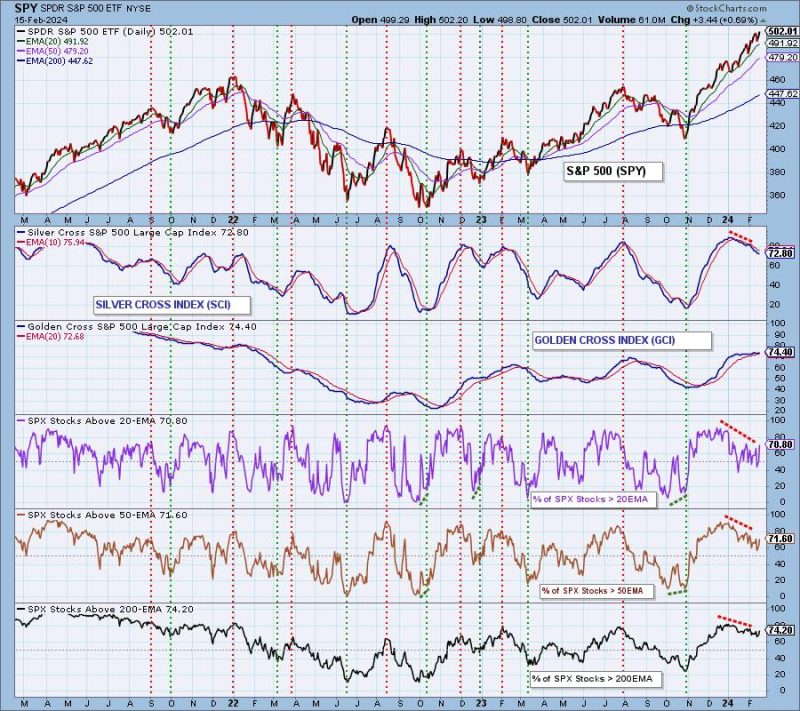February 16, 2024
Diminishing BUY Signals: A Continuing Trend
 As the global markets continue to show signs of volatility and uncertainty, investors and traders are closely monitoring the diminishing buy signals in the financial markets. The ongoing bearish trend has been fueled by a combination of factors, including geopolitical tensions, economic concerns, and the fear of a potential recession.
One of the key indicators that analysts use to assess market conditions is the buy signal. It is a signal that suggests favorable conditions for investors to purchase stocks or other financial assets. These signals are typically generated by technical analysis tools and can provide insights into potential opportunities for traders.
However, in recent months, these buy signals have been becoming increasingly scarce. The lack of opportunities has made it more challenging for investors to find profitable trades and led to a cautious approach among market participants. This trend has been particularly evident in the stock market, where investors are becoming more hesitant to buy stocks.
One factor contributing to the diminishing buy signals is the ongoing trade tensions between the United States and China. The prolonged trade war has created uncertainty and volatility in the global markets, causing investors to be more cautious. The trade dispute has led to higher tariffs, disrupted supply chains, and increased costs for businesses, which in turn has impacted corporate earnings and investor sentiment.
The weakening global economy is also playing a role in the diminishing buy signals. Many major economies, including Germany and China, are experiencing a slowdown in growth. This has raised concerns about a potential global recession, further dampening investor confidence.
Moreover, the central banks' actions have also contributed to the diminishing buy signals. After a period of monetary easing following the global financial crisis, central banks around the world are now tightening their monetary policy. This includes raising interest rates and reducing liquidity in the markets. These actions have made it more difficult for investors to find attractive investment opportunities.
Furthermore, the diminishing buy signals can also be attributed to changing trends in investor behavior. With the rise of passive investing and algorithmic trading, market dynamics have shifted. These strategies typically focus more on long-term trends and quantitative models rather than short-term buy signals. As a result, the traditional buy signals may have become less effective in predicting market movements.
In conclusion, the diminishing buy signals in the financial markets are a reflection of the current state of uncertainty and volatility. Factors such as trade tensions, a weakening global economy, central bank actions, and changing investor behavior have all contributed to the decrease in buy signals. As investors navigate these challenging market conditions, it is essential to exercise caution and consider alternative investment strategies beyond traditional buy signals.
As the global markets continue to show signs of volatility and uncertainty, investors and traders are closely monitoring the diminishing buy signals in the financial markets. The ongoing bearish trend has been fueled by a combination of factors, including geopolitical tensions, economic concerns, and the fear of a potential recession.
One of the key indicators that analysts use to assess market conditions is the buy signal. It is a signal that suggests favorable conditions for investors to purchase stocks or other financial assets. These signals are typically generated by technical analysis tools and can provide insights into potential opportunities for traders.
However, in recent months, these buy signals have been becoming increasingly scarce. The lack of opportunities has made it more challenging for investors to find profitable trades and led to a cautious approach among market participants. This trend has been particularly evident in the stock market, where investors are becoming more hesitant to buy stocks.
One factor contributing to the diminishing buy signals is the ongoing trade tensions between the United States and China. The prolonged trade war has created uncertainty and volatility in the global markets, causing investors to be more cautious. The trade dispute has led to higher tariffs, disrupted supply chains, and increased costs for businesses, which in turn has impacted corporate earnings and investor sentiment.
The weakening global economy is also playing a role in the diminishing buy signals. Many major economies, including Germany and China, are experiencing a slowdown in growth. This has raised concerns about a potential global recession, further dampening investor confidence.
Moreover, the central banks' actions have also contributed to the diminishing buy signals. After a period of monetary easing following the global financial crisis, central banks around the world are now tightening their monetary policy. This includes raising interest rates and reducing liquidity in the markets. These actions have made it more difficult for investors to find attractive investment opportunities.
Furthermore, the diminishing buy signals can also be attributed to changing trends in investor behavior. With the rise of passive investing and algorithmic trading, market dynamics have shifted. These strategies typically focus more on long-term trends and quantitative models rather than short-term buy signals. As a result, the traditional buy signals may have become less effective in predicting market movements.
In conclusion, the diminishing buy signals in the financial markets are a reflection of the current state of uncertainty and volatility. Factors such as trade tensions, a weakening global economy, central bank actions, and changing investor behavior have all contributed to the decrease in buy signals. As investors navigate these challenging market conditions, it is essential to exercise caution and consider alternative investment strategies beyond traditional buy signals.
If you would like to delve into the world of investment topics , go to our partner project Wall Street Wizardry


